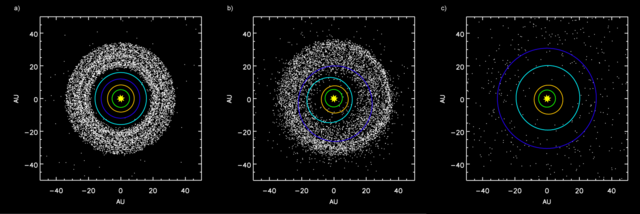 |
This is a file from the Wikimedia Commons. Information from its description page there is shown below.
Commons is a freely licensed media file repository. You can help.
|
| DescriptionLhborbits.png |
English: Simulation showing the outer planets and the Kuiper belt:
- a) Before Jupiter– Saturn 2:1 resonance.
- b) Scattering of Kuiper belt objects into the Solar System after the orbital shift of Neptune.
- c) After ejection of Kuiper belt bodies by Jupiter.
Planets shown: Jupiter (green circle), Saturn (orange circle), Uranus (light blue circle), and Neptune (dark blue circle). Simulation created using data from the Nice Model.
Français : Simulation montrant les planètes externes et la ceinture de Kuiper :
- a) Avant la résonance 2:1 de Jupiter et Saturne.
- b) Dispersion des objets de la ceinture de Kuiper dans le système solaire après la migration de Neptune.
- c) Après l'éjection d'objets de la ceinture de Kuiper par Jupiter.
L'orbite de Jupiter est représentée en vert, Saturne en orange, Uranus en bleu clair et Neptune en bleu foncé. Simulation créée sur la base de données du Nice Model
Deutsch: Eine Simulation, die die äußeren Planeten und den Kuipergürtel zeigt:
- a) Vor der Jupiter/ Saturn 2:1 Resonanz.
- b) Zerstreuung der Objekte des Kuipergürtels in das Sonnensystem, nachdem sich die Umlaufbahn Neptuns verschoben hatte.
- c) Nach dem Ausstoß von Objekten des Kuipergürtels durch Jupiter.
Gezeigte Planeten: Jupiter (grüner Kreis), Saturn (oranger Kreis), Uranus (hellblauer Kreis) und Neptun (dunkelblauer Kreis). Die Simulation wurde mit Hilfe von Daten des Nice Models erstellt.
Česky: Simulace vlivu vnějších planet na vývoj Kuiperova pásu:
- a) Kuiperův pás před tím, než se planety Jupiter a Saturn dostaly do vzájemné dráhové rezonance 2:1.
- b) Rozptýlení těles Kuiperova pásu poté, co začal měnit svou oběžnou dráhu Neptun.
- c) Rozptýlená tělesa se dostávala do vlivu Jupiteru, který je vymrštil pryč.
Zobrazené planety: Jupiter (zelený kruh), Saturn (oranžový kruh), Uran (bledě modrý kruh) a Neptun (tmavě modrý kruh). Simulace byla vytvořena za použití údajů z tzv. Modelu z Nice.
|
| Date |
|
| Source |
Own work |
| Author |
en:User:AstroMark |
Licensing
I, the copyright holder of this work, hereby publish it under the following licenses:
 |
Permission is granted to copy, distribute and/or modify this document under the terms of the GNU Free Documentation License, Version 1.2 or any later version published by the Free Software Foundation; with no Invariant Sections, no Front-Cover Texts, and no Back-Cover Texts. A copy of the license is included in the section entitled GNU Free Documentation License. http://www.gnu.org/copyleft/fdl.htmlGFDLGNU Free Documentation Licensetruetrue
|
You may select the license of your choice.
|
- ↑ a b c d Origin of the cataclysmic Late Heavy Bombardment period of the terrestrial planets, Gomes, Levison, Tsiganis, Morbidelli - Nature 26, May 2005.
File usage
The following pages on Schools Wikipedia link to this image (list may be incomplete):
Through Schools Wikipedia, SOS Children's Villages has brought learning to children around the world. SOS Children's Villages helps those who have nothing and no one, giving them back the famly they have lost and bringing them the very best opportunities for a happy, healthy future. Would you like to sponsor a child?



